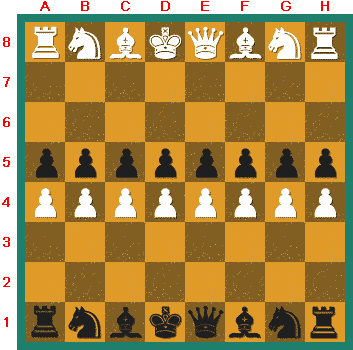Record Chess
Ralph Schuler from Switzerland invented this `chess variant game for one person', or perhaps, better stated, this chess puzzle, and wrote me about it in the summer of 1998.Rules
A position is given, and the task is to find a series of moves that reaches the position - one should try to find a series of as little moves as possible.The position Ralph Schuler gives is:
 White:
White:
King d8; Queen e8; Rook a8, h8; Knight b8, g8; Bishop c8, f8; Pawn a4, b4, c4,
d4, e4, f4, g4, h4.
Black:
King d1; Queen e1; Rook a1, h1; Knight b1, g1; Bishop c1, f1; Pawn a5, b5, c5,
d5, e5, f5, g5, h5.
How many moves do you need to reach this position?
First solution
Ralph Schuler gave the following solution:1. a4 a5 2. Nc3 Nc6 3. Nb5 Nb4 4. Ra3 Ra6 5. Rd3 Rd6 6. b3 b6 7. Bb2 Bb7 8. Bd4 Bd5 9. Na7 Na2 10. b4 b5 11. Bb6 Bb3 12. g3 g6 13. Bg2 Bg7 14. Ba8 Ba1 15. Nf3 Nf6 16. Ne5 Ne4 17. Nec6 Nec3 18. Nb8 Nb1 19. e3 e6 20. Qf3 Qf6 21. Qb7 Qb2 22. g4 g5 23. Rg1 Rg8 24. Rg3 Rg6 25. Rh3 Rf6 26. Rh6 Rf3 27. Rg6 Rg3 28. Rg7 Rg2 29. Ke2 Ke7 30. Kf3 Kf6 31. Ke4 Rc6 32. c3 Rc5 33. Rg8 d6 34. Rc8 Kg6 35. Rd4 e5 36. Rd8 Rc4 37. Kd5 f6 38. Ke6 Rg1 39. Ke7 Rh1 40. Ke8 Kg7 41. Rc8 Kg8 42. Kd8 Kf7 43. Bc5 Ke6 44. Bb6 Rg1 45. Qa6 Rh1 46. Rf4 Rg1 47. Nbc6 Kd5 48. Rf5 Ke4 49. Bc5 Kd3 50. Bb6 Kc2 51. e4 Rd4 52. Ke8 Rd3 53. Kd8 Re3 54. Ke8 Ree1 55. Rf3 f5 56. Rh3 d5 57. Rh6 Kc1 58. Rg6 h5 59. h4 Rh1 60. Ne7 c5 61. c4 Re2 62. d4 Rd2 63. f4 Kd1 64. Kd8 Qc3 65. Qb7 Qe3 66. Qd7 Qe1 67. Qe8 Bb2 68. Bb7 Bc1 69. Ra8 Nac3 70. Bc8 Ra2 71. Rh6 Ra1 72. Rh8 Ne2 73. Ng8 Ng1 74. Nc6 Bc2 75. Nb8 Bd3 76. Bc7 Be2 77. Bd6 Bf1 78. Bf8
Second solution
Alfred Pfeiffer gave a much shorter solution, November 6, 1998.1.a4 a5 2.Ra3 Ra6 3.Rb3 Rc6 4.Rb6 Rc3 5.Ra6 Ra3 6.Ra8 Ra1 7.h4 h5 8.Rh3 Rh6 9.Rf3 Rg6 10.Rf6 Rg3 11.Rh6 Rh3 12.Rh8 Rh1 13.b3 b6 14.g3 g6 15.Nf3 Nc6 16.Nd4 Ne5 17.e3 d6 18.Nc6 Nf3+ 19.Ke2 Kd7 20.Kd3 Ke6 21.Kc4 Kf5 22.Kb5 Ke4 23.Nb8 Bh3 24.Kc6 Ng1 25.Ba6 Bf1 26.d4 e5 27.Qd3+ Kf3 28.Bc8 Qg5 29.Nc3 Nf6 30.Nd5 Ne4 31.Nf6 Nc3 32.Ng8 Nb1 33.Kd7 Bh6 34.Qb5 d5 35.Kd8 f5 36.Qe8 Ke2 37.Ba3 Kd1 38.e4 Qe3 39.Bf8 Qe1 40.g4 Bc1 41.b4 b5 42.c4 c5 43.f4 g5.
He observed that the theoretical minimum is 39+x moves.
Third solution
Markus Wappler gave again a shorter solution using 40 1/2 moves, November 11, 1998:1.a4 a5 2.Ra3 Ra6 3.Rb3 Rc6 4.Rb6 Rc3 5.Ra6 Ra3 6.Ra8 Ra1 7.e4 e5 8.Ba6 Ba3 9.Ke2 Ke7 10.Kf3 Kd6 11.Kg4 Kc5 12.Kf5 Kd4 13.h4 h5 14.Rh3 Rh6 15.Rb3 Rg6 16.Rb6 Rg3 17.Rh6 Rh3 18.Rh8 Rh1 19.c4 c5 20.Qb3 Qb6 21.Qb5 Kd3 22.Nc3 Kc2 23.Nd5 Nf6 24.Ne7 Nd5 25.d3 Nc3 26.Bh6 g5 27.Ng8 Nc6 28.Kf6 Nd4+ 29.Ke7 Nde2 30.Nf3 Ng1 31.Nd4+ Kd1 32.Nc6 Nb1 33.Nb8 d5 34.Qe8 Qb4 35.Kd8 Qe1 36.Bf8 Bh3 37.g4 Bf1 38.f4 f5 39.b4 b5 40.Bc8 Bc1 41.d4
Fourth solution
Markus Wappler and Alfred Pfeiffer found together a shorter solution on November 12, 1998:1.a4 a5 2.Ra3 Ra6 3.Rb3 Rc6 4.Rb6 Rc3 5.Ra6 Ra3 6.Ra8 Ra1 7.e4 e5 8.Ba6 Ba3 9.Ke2 Nc6 10.Kf3 Nd4+ 11.Kg4 Ke7 12.Nc3 Kd6 13.Nd5 Kc5 14.Ne7 Ne2 15.Kf5 Kd4 16.h4 h5 17.Rh3 Rh6 18.Rb3 Rg6 19.Rb6 Rg3 20.Rh6 Rh3 21.Rh8 Rh1 22.c4 c5 23.Qb3 Nf6 24.Qb5 Kd3 25.Nf3 Kc2 26.Nd4+ Kd1 27.Ndc6 Nd5 28.d4 Ndc3 29.Bh6 g5 30.Kf6 Qb6 31.Ng8 d5 32.Ke7 Bh3 33.g4 Ng1 34.Nb8 Nb1 35.Qe8 Qb4 36.Kd8 Qe1 37.b4 b5 38.f4 f5 39.Bc8 Bc1 40.Bf8 Bf1
As you can see, this solution uses 40 moves, hence is close to optimal, or perhaps optimal.
Can you find a solution in even less moves? If so, email me and tell me the shorter solution, and I will publish it on this page.
Comment
This puzzle is related to the `proof game' chess problems. Of course, one can pose similar questions for other interesting positions.Written by Hans Bodlaender, based on email of Ralph Schuler. Solutions by Ralph Schuler, Alfred Pfeiffer, and Markus Wappler.
WWW page created: November 4, 1998. Last modified: November 13, 1998.